It is commonly assumed that inheritances are a major source of wealth inequality and that the offspring of wealthy families tend to be as rich as their parents due to bequests. This perception is one reason why many people support taxing estates at death. But an individual's skills and personal choices are far more important in determining household wealth than inheritances. In fact, the contribution of inheritance is surprisingly small.
More importantly, skills acquired through education, entrepreneurship and hard work determine whether individuals move from one wealth level to another. To understand the reasons for wealth inequalities, this paper relies on a model of wealth accumulation that spans individual lifetimes. It focuses on that point in the life cycle when wealth accumulation tends to peak, as married households reach retirement age (60 to 69) and have accumulated all the wealth they will during their lifetimes. The model shows the distribution of wealth is highly unequal:
- The top 1 percent of households (with wealth of $13.8 million or more) holds about 23 percent of all wealth.
- The top 5 percent ($4.02 million or more) holds 51 percent of all wealth.
However, according to the model, inherited wealth is a very small portion of total wealth even for the richest households. For example:
- If we could somehow tax away every single dollar of wealth due to inheritances, it would reduce the top 1 percent's share of the nation's total wealth by only 4 percentage points.
- If all the wealth due to inheritance of the top 5 percent were taxed away, it would reduce their share of the wealth by only 7 percentage points.
The principal argument for the estate tax is the notion that without it wealth would become more concentrated in the hands of financial dynasties. However, wealth is highly mobile – being raised in a rich family does not guarantee that these children will be rich themselves when they retire:
- Only one in five children of the rich will themselves be rich when they reach retirement age.
- On the other hand, more than half of the children whose parents are in the bottom half will end up in the top half by the time they retire.
Interestingly, Social Security has a significant effect on the distribution of wealth. Without Social Security, bequests would actually reduce wealth inequality. Specifically, if Social Security did not exist, the top 5 percent of households would hold only 46 percent of all wealth, instead of the current 51 percent.
The reason? Social Security – a pay-as-you-go program that does not save and invest – tends to replace savings that lower- and middle-income households otherwise would have accumulated. This is because for these households, expected Social Security benefits replace retirement savings. As a result, they have little or nothing to leave to their children since these benefits are not transferable. By contrast, the savings habits of higher-income households are not affected very much by Social Security.
The estate tax is ostensibly designed to reduce wealth disparities, but it has proven to be ineffective for several reasons:
- Estate tax revenues account for only 3 percent of federal tax revenues, yielding very little money to redistribute.
- For most estates larger than $5 million, the effective tax burden is only 13.5 percent to 17 percent of estates; in fact, the burden tends to fall primarily on smaller estates.
- Additionally, the estate tax lowers the capital stock while raising the return on existing capital, making the rich richer.
Economists have called the estate tax a voluntary tax, since people can avoid it if they make a large enough effort. There are social costs of tax avoidance, however. In return for trivial effects on wealth distribution, there is likely a large misallocation of resources caused when people allocate large amounts of capital based on tax law rather than on the basis of economics.
[page]The unequal distribution of income in the United States is well-studied. Less research has been done on the uneven distribution of wealth. It is important to distinguish between wealth and income. Wealth is generally the stock of assets owned by a household, and includes material possessions, as well as financial instruments such as stocks and bonds. Income is a flow of funds such as wages and other sources of income accruing in the present.
The major determinants of an individual's income are skills acquired through education and experience, and the wages received for work. The principal source of wealth is savings from income. Incomes are highly mobile, generally rising throughout the careers of individual workers and households. Although there is an association between the incomes of children and their parents, the children of the poor are likely to reach a higher level of income than their parents, and many children of high-income parents end up in a lower-income group by the time they retire.
“Wealth is highly mobile.”
Less well understood is how wealth is acquired and the fact that it is also highly mobile. It is commonly assumed that inheritances are a source of wealth inequality and the offspring of wealthy families are likely to be very wealthy when they retire. However, although bequests contribute to wealth, individual behavior is far more important. Personal choices such as skill acquisition, marriage and the decision to have children can interact in important ways with public policy choices, including the nature of the tax system, capital markets and Social Security. These factors exert a significantly larger effect on wealth accumulation and intergenerational wealth mobility than bequests alone. Hence, just as lower-income individuals are not destined to remain in the same income bracket as their parents by the time they reach retirement, the children of the wealthy are not guaranteed to reach retirement wealthy due to inheritances from their parents.
Policymakers who support an estate tax argue that large inheritances passed on to the next generation perpetuate and exacerbate the unequal distribution of wealth. But is this true? This study presents evidence that the choices individuals make, especially about their education, work and saving are largely responsible for the inequality of wealth in the United States.
[page]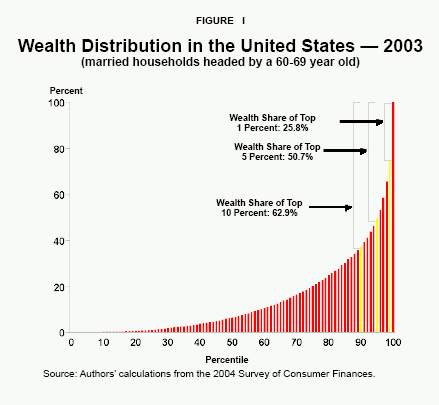
The distribution of wealth changes over time for various reasons. A 2004 National Bureau of Economic Research study found:1
- The shocks of the Great Depression, the New Deal and World War II dramatically reduced the share of wealth held by those at the top of the wealth distribution.
- This decrease is concentrated within the richest 0.1 percent of the wealth distribution, with more modest changes for lower-wealth groups within the top 1 percent.
- The shocks that large wealth-holders experienced in the first part of the century seemed to have had a permanent effect; top wealth shares increased modestly during the stock market booms of the 1960s and 1990s but are still much lower today than before the Great Depression.
Thus, contrary to the common assumption, there is little evidence that wealth is becoming more highly concentrated. It has fluctuated over the past century, but has not changed much since the 1990s.2
“The top 5 percent hold half the wealth.”
Wealth Among Retirees. The distribution of wealth also varies widely among specific demographic groups, especially among those who reach retirement age and are at the peak of their wealth accumulation over their life cycle. For example, in 2003, according to the Survey of Consumer Finances:3
- The top 1 percent of wealth holders in the United States (with lifetime accumulated wealth of $13.8 million per household or more) held nearly 26 percent of the wealth among married households ages 60 to 69. [See Figure I.]
- The top 5 percent of wealth holders (with accumulated wealth of $4.02 million or more per household) had almost 51 percent.
- The top 10 percent had about 63 percent of the wealth.
- By contrast, the bottom half of the income distribution had only 6 percent of the wealth.
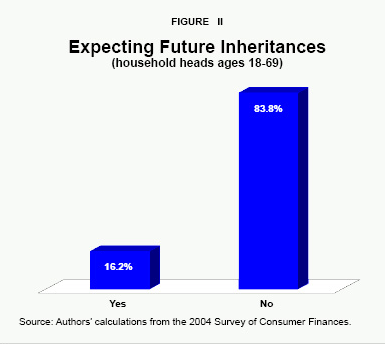
Several reasons account for unequal wealth distribution among those reaching retirement, including how much they earned and saved throughout their lifetimes, the number of children they had to support and the rate of return on their savings.4 Inheritances play a minor role.
The Role of Bequests in Wealth. Several studies have attempted to examine the link between inheritances and wealth inequality. For example, a British study found that in 1973, 58 percent of men who died with at least £100,000 in wealth had fathers who had left them at least £25,000. Moreover, 67 percent of the variation in the son's estate was explained by the size of the father's estate.5 But this does not prove that those inheritances contribute to inequality since it was unknown exactly how much sons inherited after taxes and how estates were divided among siblings.
A 1969 study by economist Joseph Stiglitz that assumed an individual's consumption increased as wealth increased found that bequests distributed evenly among adult children have an equalizing effect on the wealth distribution.6
But there is more to wealth inequality than the distribution of inheritances. Calculations from the most recent Survey of Consumer Finances show that only 16 percent of households expect to receive any inheritance, and only 2 percent of households expect to receive substantial bequests of $1 million or more in the future. [See Figure II.] Although leaving a bequest is a motivation for accumulating assets, the fact that lifespans are uncertain means that chance plays a role and bequests can occur even when there was no bequest motive to begin with. Indeed, most bequests are unplanned; they are due to incomplete annuitization – which means they occur because people do not consume all of their assets before death. Thus many bequests are randomly distributed among the children of the rich, the middle class and the poor. Interestingly:7
- For every two recent inheritances of more than $500,000 (in constant 2006 dollars) that high-earning households received, 13 were received by those with incomes of less than $200,000 a year.
- For every two large inheritances received by those with relatively high incomes since 1940, nine were received by households with relatively low incomes.
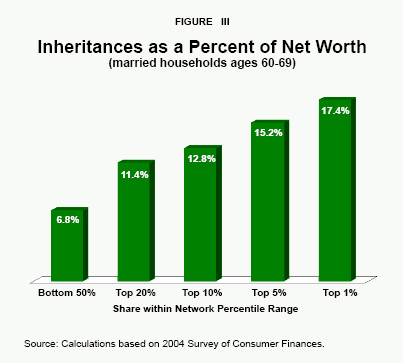
In general, the link between inheritances and wealth is very tenuous. According to data from the 2004 Survey of Consumer Finances:8
- Among the wealthiest 1 percent, with a net worth averaging $32 million per household, 17 percent of their wealth, or about $5.5 million, came from bequests. [See Figure III.]
- Among the poorest 50 percent, with a net worth averaging $158,000 per household, almost 7 percent, or $10,740 of their net wealth, was a result of bequests.
“Inheritances are a minor source of wealth.”
Even for the wealthiest households, bequests are not the primary source of wealth. According to surveys in 1998 and 2006 by the U.S. Trust Corporation:
- Nine of every 10 affluent Americans became wealthy without inheritances.9
- Earnings from a privately owned business (46 percent), corporate employment (33 percent) and a professional practice (29 percent) were more significant sources of wealth.10
Wealth in the United States is quite mobile, and many variables account for the fact that some families reach retirement far richer than others. Aside from inheritances, past empirical work indicates that three other factors determine wealth:11
- Acquired skill differences, which are determined by education, entrepreneurship, hard work and other factors that help individuals attain income and wealth;
- Marital sorting, which reflects the tendency of individuals with similar levels of acquired skills to marry each other; and
- "Inherited skills" – the innate intelligence passed down from one's parents and habits nurtured in childhood (such as disciplined work habits).
The effect of each of these factors on the distribution of wealth can be estimated through computer modeling, as the following discussion will show.
“Personal choices, innate intelligence and nurturing families determine wealth.”
Modeling Factors That Determine Wealth. The significance of inheritance and other factors on wealth can be determined using a model of the distribution of wealth in the U.S. economy based on data from the Survey of Consumer Finances. Constructed by the authors and other researchers, the model closely reproduces the actual distribution of wealth among married households nearing retirement (ages 60 to 69).12 It includes the factors that influence the distribution of wealth, such as how much parents and their children earned throughout their working lives, how much they saved, what rate of return they received on investments and when they died. Over time, the model shows the degree to which each factor, including inheritances, contributes to the distribution of wealth among the children of these households when the children reach an assumed retirement age of 66.
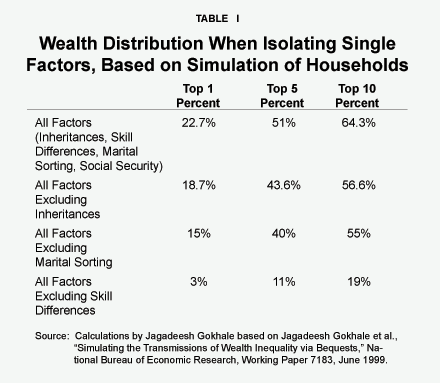
“Taxing all inheritances away would reduce the wealth share of the rich by very little.”
Consider the contribution of labor income to bequests. The findings in this simulation are similar to actual bequest flows in the United States. In the model:
- Bequests to spouses comprise about 9 percent of labor income.
- Bequests to children comprise about 3 percent of labor income.
These labor market earnings have only a small effect on wealth inequality, holding constant skill and mortality differences.
Next, consider the effect of other factors on wealth inequality. The effect of these factors are compared to a benchmark, or base, in which wealth is distributed randomly and no other factors are considered. As Table I shows:13
- The top 1 percent of households hold about 23 percent of wealth, the top 5 percent hold 51 percent of wealth and the top 10 percent hold about 64 percent of wealth.
- If the inheritances of the top 1 percent were completely taxed away, it would only reduce their share of total wealth by 4 percentage points to 19 percent.
- If the inheritances of the top 5 percent were taxed away, it would reduce their share of the wealth by only 7 percentage points to 44 percent.
- If the inheritances of the top 10 percent (accumulated lifetime wealth of $2.1 million) were taxed away, it would reduce their share of the wealth by only 8 percentage points to 57 percent.
“Taxing away all wealth derived from individual skills would reduce the wealth share of the rich by more than 80 percent.”
However, inheritances have a small effect on the wealth distribution when compared to other factors. Other differences have a much greater effect on the uneven distribution of wealth:
- If all the wealth that derives from acquired skills (gained through hard work, education, entrepreneurship and so forth) were taxed away, the share of total wealth of the top 1 percent would drop significantly, from 23 percent to only 3 percent.
- The top 5 percent of households' wealth would fall from 51 percent to 11 percent.
- The top 10 percent's wealth would fall from 64.3 percent to 19 percent.
The majority of wealth inequality stems from inequality in lifetime earnings, which are highly influenced by skills, education and motivation. In other words, wealth would be more evenly distributed if individuals had the same innate abilities, education levels, motivation and so forth. But these levels obviously vary in the real world.
[page]Wealth mobility mitigates inequality.14 While there is a great deal of literature on income mobility, there is much less on wealth mobility. The data show that incomes are highly mobile, with many of the rich becoming poor and many of the poor becoming rich within relatively short periods of time.15 For example, a study of families between 1984 and 1994 examined the income movement of households, divided into 10 equal population groups (deciles). It found:16
- Almost two-thirds of families in the bottom 10 percent of income in the first year reached a higher income group 10 years later.
- Of these, 40 percent moved up to the next decile, while slightly more than one-fourth rose two deciles and about one-tenth leaped three deciles.
- Almost one-fourth jumped four or more deciles, with 1.42 percent rising from the lowest 10 percent to the highest.
- Nearly half (47 percent) of those in the top 10 percent in 1984 were in a lower decile 10 years later.
- About 10 percent fell more than three deciles and a few ended up all the way down in the bottom 10 percent.
Wealth is also highly mobile. A study of the "Forbes 400" in 1986 identified 265 separate fortunes among this group. Of these, 108 were inherited to some degree, while 157 represented new wealth.17 The latest data show 149 of the 400 having inherited some or all of their wealth, with 251 being self-made.18 The super-rich have experienced a comeback in recent years. By 2000, the number of billionaires had shot up to 298, before falling to 266 in 2001 and 228 in 2002. In 2003, the number shot back up to 262 and in 2004 to 313.19
Because wealth is highly mobile in the United States, most fortunes are earned, rather than inherited, and rarely survive past the second generation. For instance, according to data from the Internal Revenue Service:
- More than 2,218 taxpayers made the list of the 400 richest Americans profiled each year in Forbes magazine at some point between 1995 and 2003.
- Three-fourths of those 2,218 made the cut for only one year.
- Most (87 percent) were only listed one or two years, and less than 1 percent made the cut every year.
“Most children of the super-rich will not be rich.”
Moreover, being raised in a super-rich family does not guarantee that children will be super-rich as adults. For instance, when the children of today's retiree households (those headed by an adult between the ages of 60 and 69) themselves reach retirement age:
- Only 21 percent of children in the top 5 percent of households – those with accumulated wealth of at least $4.0 million – will be in this wealth range when they retire.
- Furthermore, more than one-fourth (30.2 percent) of children whose parents are in the top 5 percent will drop to the bottom 80 percent when they retire.
- More than half of children (52.6 percent) of parents in the bottom 50 percent of the wealth distribution (with accumulated wealth of less than $387,000) will be in the upper 50 percent of the wealth distribution when they retire.
- About 4 percent of children in the bottom 50 percent will retire in the top 20 percent of the wealth distribution.
According to the 2004 Survey of Consumer Finances, only 20 percent of today's retirees have more than $1 million for retirement, and only 4 percent of them have more than $5 million. But despite large bequests, most of the children of the rich will not do as well. In fact, 43 percent of them will arrive at retirement within the poorest 80 percent of the population because their skill levels and earnings are likely to be lower than that of their high-skilled parents. But wealth and poverty are never static. Americans of all classes often move up and down the economic ladder depending on their personal circumstances and the state of the economy at a given point.
Causes of Mobility. Entrepreneurship accounts for a large degree of mobility in and out of wealth in the United States. Entrepreneurs gain and lose wealth faster than workers.20 Hence, economists agree that a high degree of entrepreneurship is essential to growth, and in turn creates a higher degree of wealth concentration – which is mitigated by a higher degree of mobility.
Many other factors also help explain the fact that wealth is frequently dissipated, and why the nouveaux riche are consistently able to break into the ranks of the wealthy. One factor is that rich men tend to marry younger women who outlive them and eventually consume the family fortune. The sons and daughters of the wealthy often show no interest in running the family business or lack the skills to do so well. Finally, a significant number of the rich die childless or leave their fortunes to charity.21
[page]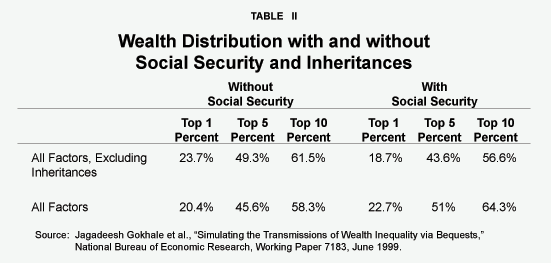
“Wealth would be distributed more evenly without Social Security.”
As noted, inheritances have only a minor effect on wealth inequality. Without Social Security, however, bequests would actually reduce wealth inequality. How can this be? In general, Social Security taxes tend to crowd out personal saving, leaving consumption unchanged. Because expected Social Security benefits are sufficient to maintain their preretirement consumption, lower-income households reach retirement with very little personal savings. If they die prematurely, however, they cannot pass Social Security benefits onto their children. By contrast, higher-income households, having saved to maintain their consumption level after retirement, will transfer substantial wealth to their children if they die prematurely, aside from Social Security.22 Hence, if Social Security were absent, low-earning households would arrive at retirement on a more equal footing with high-earning ones, and their bequests to the next generation would actually reduce wealth inequality.
The model allows the simulation of the wealth distribution: 1) with and without Social Security, 2) with inheritances and 3) hypothetically taxing all inheritances away. Table II shows some of the results:
- Without Social Security, the top 1 percent would hold 20.4 percent of the national wealth, but this would increase to 23.7 percent if all inherited wealth were taxed away.
- In the presence of Social Security, however, the share of national wealth held by the top 1 percent would shrink from 22.7 percent of wealth to 18.7 percent of wealth if all inheritances were taxed away.
“Social Security reduces savings and can’t be passed on to children.”
In other words, in the absence of Social Security, allowing bequests to flow to heirs without taxation would have a wealth-equalizing effect. For example, Table II shows that the top 5 percent of households would own 49.3 percent of all wealth if all inheritances were taxed away, but only 45.6 percent if inheritances were not taxed. As noted earlier, the involuntary bequests of high earners and savers would go to their children who, on average, are likely to earn and save less than their parents.
Introducing Social Security, however, saps the incentive and ability of low- and middle-earners to save for retirement. Higher payroll taxes mean lower ability to save, and expected future retirement benefits weaken the incentive to save. That means the distribution of bequeathable wealth is less equal, assuming inheritances are not eliminated through taxation. For example, the top 5 percent of those just retired would own 51 percent of all wealth if inheritances are not taxed compared to just 43.6 percent if a 100 percent tax is imposed.
Not only does Social Security increase wealth inequality, it is also likely to make it dynastically more persistent. This happens simply because Social Security makes the distribution of bequeathable wealth more unequal. In its presence, the children of the rich receive much more by way of inheritances than do those of poor- and middle-earners. This improves the chance that the children of high-earners will themselves arrive at retirement with more wealth than the children of low- or middle-earners.23
Some supporters of wealth redistribution through estate taxes argue that we should abolish inheritances by taxing them away so that (with Social Security) we will reduce inequality by as much as possible. As shown in the top right panel of Table II, the lowest inequality in the top tail of the wealth distribution would occur if inheritances were fully taxed and Social Security retained. However, abolishing inheritances would be unfair to those who have a bequest motive and would act as a further disincentive to save, acquire education and invest in bequeathable physical or financial assets. In fact, it is Social Security that has made the wealth distribution more unequal; absent Social Security, inheritances would be wealth equalizing.
[page]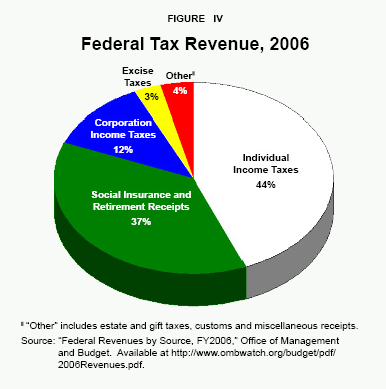
In the current debate over eliminating the estate tax, or returning to pre-2001 levels, there are two major arguments. One is that the federal government needs the revenue; the other is that the estate tax mitigates wealth inequality. Indeed, some argue that in its absence, wealth would become more highly concentrated into fewer and fewer hands.
In most countries, including a number of developed countries in the Organization for Economic Cooperation and Development (Finland, France, Germany, Iceland, Luxembourg, the Netherlands, Norway, Spain, Sweden and Switzerland),24 the majority of wealth is concentrated in a fairly small number of hands, making a wealth tax appealing to politicians since it allows substantial amounts of revenue to be raised from comparatively few people.25
“Estate taxes are a minor source of federal revenue.”
However, critics argue that estate taxes create economic inefficiencies by discouraging wealth-creating activities, resulting in slower economic growth. Moreover, the revenue collected may prove disappointing, since the wealthiest people are often the most skilled at tax avoidance. In the United States, estate taxes account for less than 3 percent of total federal tax revenue. [See Figure IV.]
“Estate tax rates will rise in 2010.”
From Revenue to Redistribution. An estate tax was legislated in 1916 to pay for World War I, and it has remained in force since.26 The initial top rate was just 10 percent, suggesting that its original purpose was to raise revenue, rather than redistribute wealth. The estate tax did not become explicitly redistributive until the administration of Franklin Roosevelt. The Revenue Act of 1935, in particular, was almost solely concerned with redistribution. The top estate tax rate, which was 45 percent when Roosevelt took office, was ratcheted up to 60 percent in 1934 and 70 percent in 1935.27 The 2001 Economic Growth and Tax Relief Reconciliation Act is temporarily phasing out the estate tax. Tax rates are falling and the amount of wealth exempted from the tax is rising. In 2009, the tax will disappear, only to return in 2010 at the same rates that existed before the temporary tax cut.
Today the estate tax exists almost exclusively for redistributive purposes, since the revenue yield is minuscule. The estate and gift tax is the federal government's least significant revenue source.28 [Note that if the estate tax were abolished, most bequests would still be subject to capital gains taxation when assets are sold – generating offsetting revenue increases.]
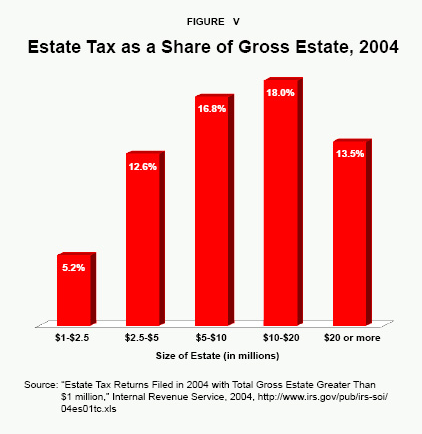
Current Estate Tax. For 2006, the top estate tax rate is 46 percent. However, the average effective estate tax rate – the percentage of the total estate actually paid in taxes – is much lower. In 2001, when the top rate was 55 percent, the average effective estate tax rate was only 19 percent. Today, with a lower top rate and a higher exemption ($2 million), the average effective tax rate is even lower.29 In fact, after a certain point, the estate tax burden tends to fall as the size of estates increases, leaving those with smaller estates to shoulder a greater proportion of the tax. For instance:
- The effective estate tax rate on estates of $5 million to $10 million is 16.8 percent. [See Figure V.]
- However, for estates of $20 million or greater, the tax consumes only 13.5 percent of the estate.
Despite the reduced estate tax rate since 2001, the United States still has the third-highest top estate tax rate in the world at 46 percent; only Japan's (70 percent) and South Korea's (50 percent) rates are higher.30
Burden of the Estate Tax. A fundamental justification for the estate tax is that it is paid only by those who can most easily afford it, namely the rich. Today, roughly one-half of one percent of those who die leave estates that are subject to the tax.31 However, the burden of the tax falls primarily on the recipient, not the giver. For this reason, one cannot state with certainty what the distributional effect of the estate tax actually is, since heirs may be either wealthy or poor. This alone may be a sufficient reason to abolish the estate tax.32
The fact that the burden of the estate tax falls on heirs rather than decedents has important distributive implications. Generally speaking, heirs have less wealth and income than decedents who leave large bequests. Hence, it would make more sense to tax the heirs rather than the estates alone. Attributing the estate tax to the heirs rather than the estates would show the burden of the estate tax on those with middle incomes to be much higher than standard distributional tables indicate. Indeed, Congress's Joint Committee on Taxation has resisted inclusion of the estate tax in its tables showing the distribution of the tax burden by income groups, owing to uncertainty about who actually bears the burden of the tax.33
Redistributive Effects. Ironically, the deleterious impact of the estate tax on saving and capital formation negates much of the redistributive effect of the tax. According to Joseph Stiglitz, to the extent that the estate tax reduces the capital stock, it raises the return to the remaining capital.34 Since the rich already own most of the existing capital, the effect of the estate tax is actually to make them richer. Consequently, it is not surprising that existing high estate tax rates appear to do virtually nothing to equalize the distribution of wealth.35
[page]Wealth mobility is determined by a variety of factors. Inheritances play only a small role in determining an individual's wealth upon retirement. Earnings inequality, as a result of inherited and acquired skills, marital sorting and Social Security, are far more important determinants of one's wealth at retirement. In fact, in the absence of Social Security, inheritances would actually increase wealth equality, but in the presence of Social Security, wealth inequality is increased. This is because Social Security's regressive tax and progressive benefits affect the saving incentives of lower-income families while having little effect on wealthy families. The resulting distribution of bequests, and therefore the distribution of the next generation's wealth at retirement, becomes more unequal.
The estate tax generates very little revenue for the federal government. Because inheritances are only a minor factor determining the wealth distribution among retirees, using the estate tax as a redistributive mechanism is unlikely to have a significant effect on that distribution. Indeed, it may be self-defeating if it slows capital formation: The resulting increase in capital returns would make the rich even richer.
[page]
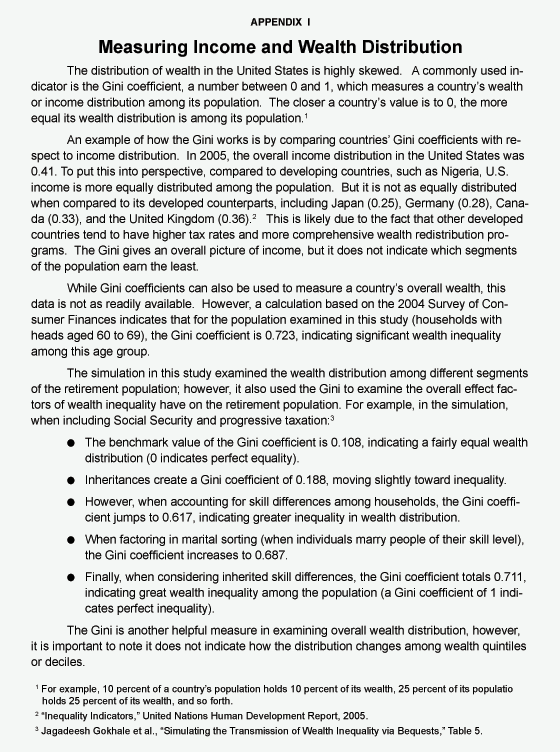
[page]
- Wojciech Kopczuk and Emmanuel Saez, "Top Wealth Shares in the United States, 1916-2000: Evidence from Estate Tax Returns," National Bureau of Economic Research, Working Paper No. 10399, March 2004.
- Marco Cagetti and Mariacristina De Nardi, "Wealth Inequality: Data and Models," Federal Reserve Bank of Chicago, Working Paper 2005-10, August 17, 2005.
- Authors' calculations based on data from the "2004 Survey of Consumer Finances," Federal Reserve Board. Available at http://www.federalreserve.gov/Pubs/oss/oss2/2004/scf2004home.html. The wealth distributions reported here consider only married households with at least one spouse near retirement age.
- Jagadeesh Gokhale, Laurence J. Kotlikoff, James Sefton and Martin Weale, "Simulating the Transmission of Wealth Inequality via Bequests," National Bureau of Economic Research, Working Paper 7183, June 1999; and Jagadeesh Gokhale et al., "Simulating the Transmission of Wealth Inequality via Bequests," Journal of Public Economics, Vol. 79, 2001, pages 93-128.
- C.D. Harbury and D.M.W.N. Hitchens, Inheritance and Wealth Inequality in Britain (London: George Allen and Unwin, 1979). Cited in Jagadeesh Gokhale et al., "Simulating the Transmission of Wealth Inequality via Bequests."
- Joseph E. Stiglitz, "Distribution of Income and Wealth Among Individuals," Econometrica, Vol. 37, No. 3, pages 382-97. Cited in Jagadeesh Gokhale et al., "Simulating the Transmission of Wealth Inequality via Bequests."
- Calculations based on data from the "2004 Survey of Consumer Finances," Federal Reserve Board. Available at http://www.federalreserve.gov/Pubs/oss/oss2/2004/scf2004home.html.
- Ibid.
- Bart Ganzert, "Wealthy Woes: Affluent Americans Concerned Heirs Will Face More Challenges," Bizjournal.com, July 28, 2006; based on survey data from U.S. Trust Corporation, "Affluent Survey: 2006," July 2006.
- U.S. Trust Corporation, A Portrait of the Affluent in America Today (New York: U.S. Trust Corporation, 1998).
- Jagadeesh Gokhale et al., "Simulating the Transmission of Wealth Inequality via Bequests," National Bureau of Economic Research, Working Paper No. 7183, June 1999. Also, see A.S. Blinder, "Inequality and Mobility in the Distribution of Wealth," Kyklos, Vol. 29, pages 607-38.
- This age range was selected based on the assumption that individuals in their 60s have likely accumulated most of their wealth that is obtained from labor earnings.
- Jagadeesh Gokhale et al., "Simulating the Transmission of Wealth Inequality via Bequests." This simulation involved using computer models to contract an "overlapping generations model" to reflect the existing economy on a smaller scale. The model uses 2000 couples (a 22-year-old male married to a 22-year-old female), where each individual who is killed lives a maximum of 88 years. Oldsters are killed off at random after age 66, and those whose spouses die first pass their estates on to the surviving spouse, while those whose spouses are no longer living pass their estates on to their children. The bequests are not planned; rather, they are not fully annuitized because of premature death, so the inheritances are random. Each worker was assigned an annual wage of $1 to represent a skill level of 1; future earnings and skill levels are then based on a representative sample of the U.S. population. The model also assumes a 4 percent rate of return on earnings. The simulation was closely approximate to actual wealth distribution in the United States: the model indicated that the top 1 percent of retiring households held 32.8 percent of wealth, and actual data from the Survey of Consumer Finances reveals that the top 1 percent of retiring households hold 30.4 percent of wealth.
- Anthony Shorrocks, "Income Inequality and Income Mobility," Journal of Economic Theory, Vol. 19, December 1978, pages 376-93; and Young Back Choi, "On the Rich Getting Richer and the Poor Getting Poorer," Kyklos, Vol. 52, No. 2, 1999, pages 239-58.
- Bruce Bartlett, "Wealth, Mobility, Inheritance and the Estate Tax," National Center for Policy Analysis, Policy Report No. 235, July 2000; and Greg J. Duncan, Years of Poverty, Years of Plenty (Ann Arbor, Mich.: Survey Research Center, Institute for Social Research, University of Michigan, 1984); Isabel V. Sawhill and Mark Condon, "Is U.S. Income Inequality Really Growing?" Urban Institute, Policy Bites, June 1992; Thomas L. Hungerford, "U.S. Income Mobility in the Seventies and Eighties," Review of Income and Wealth, Vol. 39, December 1993, pages 403-17; and W. Michael Cox and Richard Alm, By Our Own Bootstraps: Economic Opportunity and the Dynamics of Income Distribution (Federal Reserve Bank of Dallas, 1995).
- Bruce Bartlett, "Wealth, Mobility, Inheritance and the Estate Tax."; and Erik Hurst, Ming Ching Luoh and Frank Stafford, "The Wealth Dynamics of American Families, 1984-1994," Brookings Institution, Papers on Economic Activity No. 1, 1998, pages 267-337.
- Rudolph C. Blitz and John J. Siegfried, "How Did the Wealthiest Americans Get So Rich?" Quarterly Review of Economics and Finance, Vol. 32, Spring 1992, pages 5-26, as referenced by Bruce Bartlett, "Wealth, Mobility, Inheritance and the Estate Tax."
- "The Forbes 400 by the Numbers," Forbes, October 11, 1999, page 10; cited in Bruce Bartlett, "Wealth, Mobility, Inheritance and the Estate Tax."
- Joseph Kay, "Forbes 400 List of Richest Americans: Snapshot of Financial Oligarchy," Forbes, September 21, 2004; Available at http://www.wsws.org/articles/2004/sep2004/forb-s27.shtml.
- Vincenzo Quadrini, "Entrepreneurship, Saving, and Social Mobility," Review of Economic Dynamics, Vol. 3, January 2000, pages 1-40; cited in Bruce Bartlett, "Wealth, Mobility, Inheritance and the Estate Tax."
- Stanley Lebergott, The American Economy: Income, Wealth and Want (Princeton University Press, 1976), pages 190-97; cited in Bruce Bartlett, "Wealth, Mobility, Inheritance and the Estate Tax."
- Jagadeesh Gokhale et al., "Simulating the Transmission of Wealth Inequality via Bequests."
- Jagadeesh Gokhale et al., "Simulating the Transmission of Wealth Inequality via Bequests." In another model, the effect of progressive taxation was introduced. While progressive taxation does not change the finding that inheritances reduce wealth inequality absent Social Security, it does change the effect in the presence of Social Security by limiting the wealth accumulation of the poor and the middle class and reducing the flow of bequests to children. Progressive taxation also imposes a higher burden on high-income households thereby reducing their wealth accumulation. Hence, progressive taxation reduces wealth inequality only slightly.
- Organization for Economic Coordination and Development, "Challenges for Tax Policy in OECD Countries," OECD Economic Outlook, No. 69, Chapter 5, June 2, 2001. Available at http://www.oecd.org/dataoecd/44/0/2086223.pdf
- "Economics A-Z," Economist. Available at http://economist.com/research/Economics/alphabetic.cfm?LETTER=W#wealthtax.
- Barry W. Johnson and Martha Britton Eller, "Federal Taxation of Inheritance and Wealth Transfers," in Robert K. Miller and Stephen J. McNamee, eds., Inheritance and Wealth in America (New York: Plenum Press, 1998), pages 61-90.
- Roy G. Blakey and Gladys C. Blakey, "The Revenue Act of 1935," American Economic Review, Vol. 25, December 1935, pages 673-90; Harley L. Lutz, "The Federal Reserve Act of 1935," American Economic Review, Vol. 26, March 1936, pages 161-73; Truman C. Bigham, "Economic Effects of the New Deal Tax Policy," Southern Economic Journal, Vol. 3, January 1937, pages 270-80; Joseph A. Schumpeter, Business Cycles, 2 vols. (New York: McGraw-Hill, 1939), page 1,039.
- "Federal Revenues by Source, FY2006," Office of Management and Budget. Available at http://www.ombwatch.org/budget/pdf/2006Revenues.pdf.
- "Frequently Asked Questions about the Estate Tax," Fair Economy. Available at http://www.faireconomy.org/estatetax/ETFAQ.html.
- "New International Survey Shows U.S. Death Tax Rate among Highest," American Council for Capital Formation, July 2005. If the current estate tax laws are allowed to expire, the United States' top marginal estate tax rate could increase to 55 percent in 2011.
- Joel Friedman and Aviva Aron-Dine, "The State of the Estate Tax as of 2006," Center on Budget and Policy Priorities, June 2, 2006.
- Geoffrey Brennan, "Death and Taxes: An Attack on the Orthodoxy," Public Finance, Vol. 33, No. 3, 1978, pages 201-23.
- Ryan J. Donmoyer, "Estimating Estate Tax Burden Is Troubling Issue for JCT," Tax Notes, Vol. 84, August 2, 1999, pages 651-52. Also, see John A. Miller and Jeffrey A. Maine, "Fundamentals of Estate Tax Planning," Idaho Law Review, Vol. 32, No. 2, 1996, pages 197-252; Christopher Drew and David Cay Johnston, "For Wealthy Americans, Death Is More Certain Than Taxes," New York Times, December 22, 1996. George Cooper, A Voluntary Tax? New Perspectives on Sophisticated Estate Tax Avoidance (Washington, D.C.: Brookings Institution, 1979), page 4; Henry J. Aaron and Alicia H. Munnell, "Reassessing the Role for Wealth Transfer Taxes," National Tax Journal, Vol. 45, June 1992, page 138. The reason for this disparity is that careful estate planning can virtually eliminate the tax. Thus for most married couples, the estate tax only applies to estates larger than $1.35 million. Beyond that, there are a number of increasingly complex methods for reducing the estate tax burden.
- Joseph E. Stiglitz, "Notes on Estate Taxes, Redistribution, and the Concept of Balanced Growth Path Incidence," Journal of Political Economy, Vol. 86, April 1978, pages S137-S150.
- As Alan Blinder observes, "Estate taxation is not a very powerful weapon in the egalitarian arsenal….The reformer eyeing the estate tax as a means to reduce inequality had best look elsewhere." Alan S. Blinder, "Inequality and Mobility in the Distribution of Wealth," Kyklos, Vol. 29, No. 4, 1976, pages 618-19.
Jagadeesh Gokhale is a senior fellow with the Cato I nstitute in Washington, D.C. His research focuses on U.S. fiscal policy, entitlement reforms, intergenerational redistribution, national saving, and labor productivity and compensation. He works with Cato's Project on Social Security Choice to develop reforms for programs such as Social Security and Medicare. Dr. Gokhale served in 2002 as a consultant to the U.S. Department of the Treasury and in 2003 as a visiting scholar with the American Enterprise Institute (AEI). Earlier, he was senior economic adviser to the Federal Reserve Bank of Cleveland. His most recent book, Fiscal and Generational Imbalances: New Budget Measures for New Budget Priorities, coauthored with Kent Smetters, drew widespread attention when it was published by AEI. He has also authored numerous papers in such economic journals as the American Economic Review, Journal of Economic Perspectives and the Quarterly Journal of Economics. Gokhale holds a Doctor of Philosophy degree in economics from Boston University.
Pamela Villarreal is a graduate student fellow at the National Center for Policy Analysis. She received a Bachelor of Science in Economics degree from the University of Texas at Dallas in 2003, and a Master of Science in Applied Economics degree in the summer of 2006. Ms. Villarreal has authored or coauthored a number of NCPA publications on such diverse topics as the estate tax, Medicaid reform, big-box retailers and aid for Hurricane Katrina evacuees.
She is currently pursuing a doctorate in public policy and political economy from the University of Texas at Dallas.